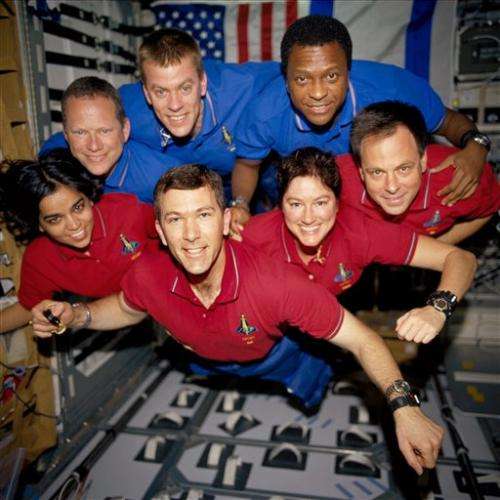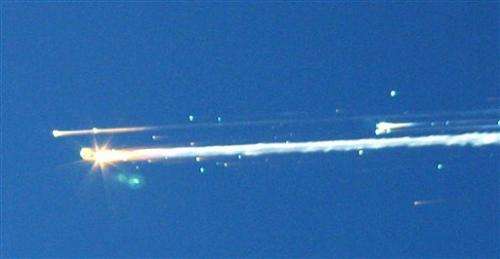This photo provided by NASA in June 2003 shows STS-107 crew members,from the left (bottom row), wearing red shirts to signify their shift's color, are astronauts Kalpana Chawla, mission specialist; Rick D. Husband, mission commander; Laurel B. Clark, mission specialist; and Ilan Ramon, payload specialist. From the left (top row), wearing blue shirts, are astronauts David M. Brown, mission specialist; William C. McCool, pilot; and Michael P. Anderson, payload commander. The astronauts were killed on Feb. 1, 2003, in the final minutes of their 16-day scientific research mission aboard Columbia. Altogether, 12 children lost a parent aboard Columbia. The youngest is now 15, the oldest 32. (AP Photo/NASA, File)
A NASA top official wrestled with what he thought was a hypothetical question: What should you tell the astronauts of a doomed space shuttle Columbia?
When the NASA official raised the question in 2003 just days before the accident that claimed seven astronauts' lives, managers thought—wrongly—that Columbia's heat shield was fine. It wasn't. Columbia, NASA's oldest shuttle, broke apart over Texas 10 years ago Friday upon returning to Earth after a 16-day mission.
But the story of that question—retold a decade later—illustrates a key lesson from the tragedy, says Wayne Hale, a flight director who later ran the shuttle program for NASA.
That lesson: Never give up. No matter how hopeless.
And to illustrate the lesson, Hale in his blog tells for the first time the story of his late boss who seemingly suggested doing just that. The boss, mission operations chief Jon Harpold, asked the now-retired Hale a what-if question after a meeting that determined—wrongly—that Columbia was safe to land despite some damage after takeoff.
"You know there is nothing we can do about damage to the (thermal protection system)," Hale quotes Harpold a decade later. "If it has been damaged, it's probably better not to know. I think the crew would rather not know. Don't you think it would be better for them to have a happy successful flight and die unexpectedly during entry than to stay on orbit, knowing that there was nothing to be done until the air ran out."
When Harpold raised the question with Hale in 2003, managers had already concluded that Columbia's heat shield was fine. They told astronauts they weren't worried about damage from foam insulation coming off the massive shuttle fuel tank during launch, hitting a wing that allowed superheated gases in when the shuttle re-entered the atmosphere. No one was aware of the seriousness of the damage at the time.
This was a what-if type question that conveyed a fatalistic attitude about the heat shield system being unfixable, which was "a wrong-headed cultural norm that we had all bought into," Hale said in a Thursday telephone interview.
"There was never any debate about what to tell the crew," he said.
In fact, NASA officials were overconfident in the heat shield on Columbia. A day after launch, NASA saw video of the foam from the shuttle's fuel tank hit the shuttle wing, something that had happened before. NASA officials studied the damage and determined it wasn't a problem.
NASA managers even sent the crew a 15-second video clip of the foam strike and "made it very clear to them no, no concerns," according to the independent board that later investigated the accident. Eight times, NASA had the opportunity to get a closer look at the damage— using military satellites—and NASA mistakenly ignored those chances to see how bad the problem was, the accident board concluded.
In this Feb. 1, 2003 file photo, debris from the space shuttle Columbia streaks across the sky over Tyler, Texas. The Columbia broke apart in flames 200,000 feet over Texas on Saturday, killing all seven astronauts just minutes before they were to glide to a landing in Florida. Ten years later, reminders of Columbia are everywhere, including up in the sky. Everything from asteroids, lunar craters and Martian hills, to schools, parks, streets and even an airport (Rick Husband Amarillo International Airport) bear the Columbia astronauts' names. Two years ago, a museum opened in Hemphill, Texas, where much of the Columbia wreckage rained down, dedicated to "remembering Columbia." About 84,000 pounds of that wreckage, representing 40 percent of NASA's oldest space shuttle, are stored at Kennedy and loaned for engineering research. (AP Photo/Scott Lieberman)
And had NASA realized the severity of the problem, the space agency would not have just let the astronauts die without a fight or a word, despite Harpold's hypothetical question, Hale said.
"We would have pulled out all the stops. There would have been no stone left unturned. We would have had the entire nation working on it," Hale said. Ultimately, Hale said he thinks whatever NASA would have tried in 2003 with limited time and knowledge probably would have failed.
And the astronauts would have been told about the problem and their fate had engineers really known what was happening, Hale said.
When NASA started flying shuttles again, Hale told the new team of mission managers: "We are never ever going to say that there is nothing we can do."
NASA developed an in-flight heat shield repair kit.
The space shuttles were retired in 2011. Harpold died in 2004.
Hale said he is now writing about the issue because he wanted future space officials not to make the mistakes he and his colleagues did. The loss of the Columbia astronauts—people he knew—still weighs on Hale.
"You never get over it. It's always present with you," Hale said. "These are people I knew well. Several of them, I worked closely with. I was responsible for their safety. It's never going to go away."
Copyright 2013 The Associated Press. All rights reserved. This material may not be published, broadcast, rewritten or redistributed.






















